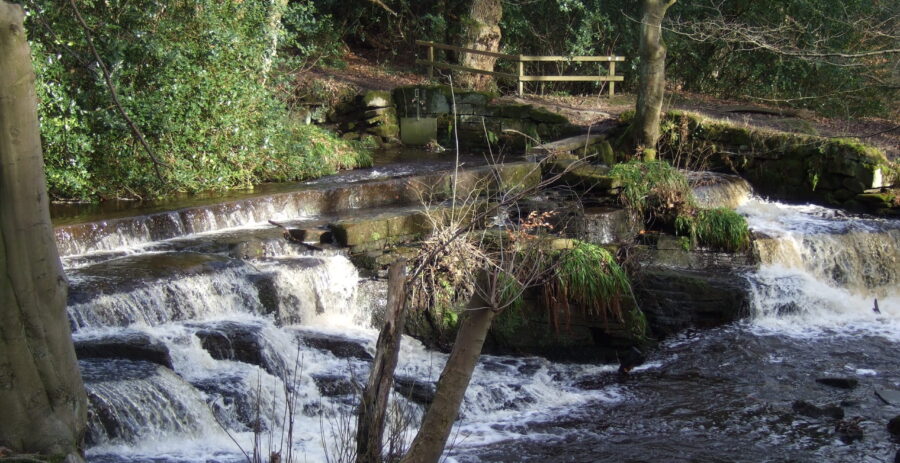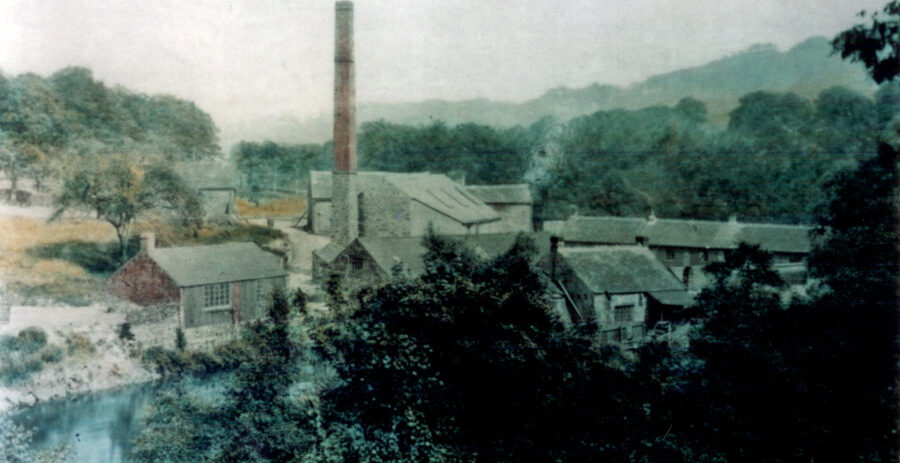
Introduction
First leased to John Hoyland & Joseph Spooner in 1758, this site was initially used for cutlery grinding and later converted to a paper mill. By 1905 the site was empty.
The wide Third Coppice weir is one of the most attractive features of the Rivelin Valley. It uses a natural waterfall which has been raised by a single course of stone blocks stapled together. It can be crossed (with care) when water levels are sufficiently low.
The mill dam still holds water, but is silted and partially overgrown. It is hard to believe that there was once an extensive complex of buildings here, as the site is now largely obscured by landslip.
History (c. 1750s–1900s)
Also known as: Rivelin Paper Mill.
Main trades: Cutlery grinding; paper mill; rolling house.

The first lease for Third Coppice Wheel was in 1758 to John Hoyland & Joseph Spooner for 21 years. By 1794, the lease had passed to William Creswick who employed four men at four cutlers’ trows, but by 1814, when it was converted to a paper mill, there were 13 trows.
Paper-making (likely made from rags and old rope) at this mill required good clean water, which was brought across from the Black Brook (on the opposite side of the river) in an aqueduct from just above the Black Brook waterfall, as shown in a drawing by C. Thomson.
In 1852 the property comprised one paper mill, two drying houses, a rope shed, a long rolling house, stables and cowshed, nd a dwelling, along with several other buildings. Like Frank Wheel (next downstream), the last known lease for this property was to Horatio & Thomas Marsden in 1889. By 1905 both sites were described as empty.
What's there now?
The Third Coppice weir uses a natural waterfall raised by a single course of stone blocks stapled together, and is probably one of the most photographed spots along the river. Look out for the large metal straps holding the stone blocks together along the top. Unfortunately, this weir was damaged in 2023 during Storm Babet – repairs are planned for 2025.
The head goit is very short, now with a modern shuttle gate on the entry. The mill dam still holds water, but is silted and partially overgrown. The overflow is only a few metres from the head goit entry. Water was re-introduced to the Third Coppice mill dam by the RVCG in 2001 (with help from the Sheffield Conservation Volunteers), by re-building the collapsed overflow, topping with a new series of stepping-stones and fitting a new shuttle gate on the head goit entry.
It is hard to believe that there was once an extensive complex of buildings here, as the site is now largely obscured by landslip. The bottom of the wheel pit was below the level of the river in order to increase the fall of water, thereby allowing a larger waterwheel to be used – in 1794 the wheel pit was recorded as having a fall of 18 ft 4 in (c. 5.6 m).
The long tail-goit (c. 150 m), which in the lower part is separated from the river by a low stone wall (now broken in places), allowed the fall in the river to match the water level in the tail goit and avoid water backing up the channel.
Nature and wildlife at Plonk Wheel
In 1936 there were many Irises in the mill dam, but these have disappeared and it is now heavily shaded by alder, sycamore and willow. Plants seen around this dam include Celandine, Creeping Buttercup, Goose-grass, Nettle, Golden Saxifrage, Pendulous Sedge, Stitchwort, Violet, Water Mint, Great Woodrush and Wood Sorrel.
Across the river from the weir there is a different type of woodland from that which edges much of the river. The trees are mainly oak but in the middle are some large beeches. Beech casts a very heavy shade and has its main roots just below the surface, so that the undergrowth is sparse except for a few fungi in autumn. Here Blue Tit, Great Tit, Long-tailed Tit and Coal Tit may be seen, in pairs in summer or in larger mixed flocks in winter, with Goldcrest and Treecreeper. This part of the river is also a good place to watch for Dippers, particularly in spring and summer. These birds are rarely seen far from water; they perch on stones in the stream and bob up and down (‘dipping’) while feeding on small insects.
Alongside the river below the large field just downstream of the Wheel site, look down at the river to see a low stone wall, covered in moss and Great Woodrush, which marks the end of the tail goit from Third Coppice Wheel.
A short way upstream from the field, look across the river to the waterfall on the Black Brook – this is another of the most photographed spots in the valley and another good place from which to watch for birds. Clean water from the brook was fed into the Third Coppice Wheel (Rivelin Paper Mill) via an aqueduct across the river.
Art
Location
The site of the Third Coppice Wheel lies to the south of Rivelin Valley Road, about 400 m downstream from Rails Road. The site is owned by Sheffield City Council and there is open access. A public footpath along the valley passes the site. A marker post installed at the site by Rivelin Valley Conservation Group gives a brief history and links to this website.
Nearest postcode: S6 5SH
OS map grid reference: SK 2954 8735
